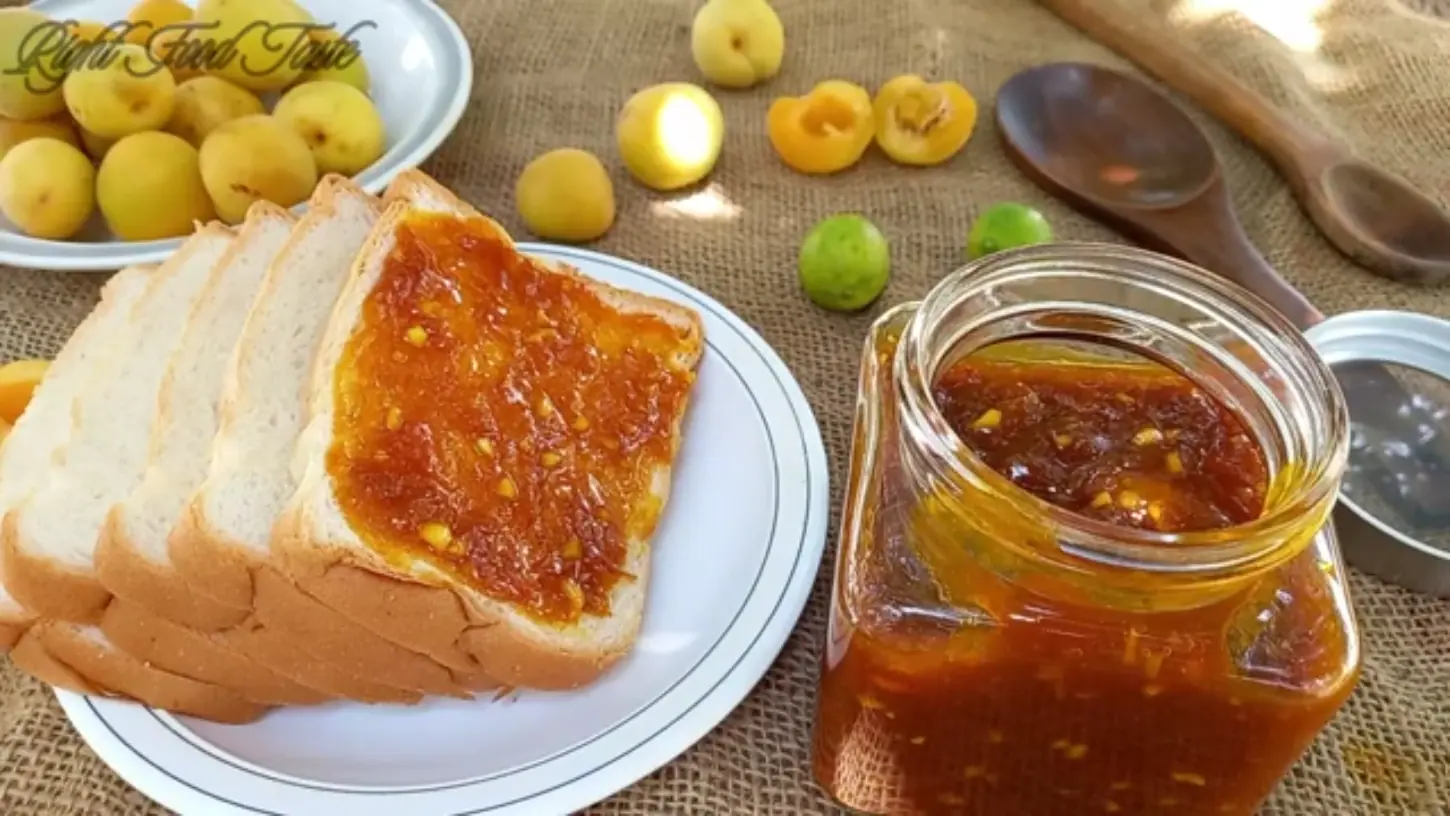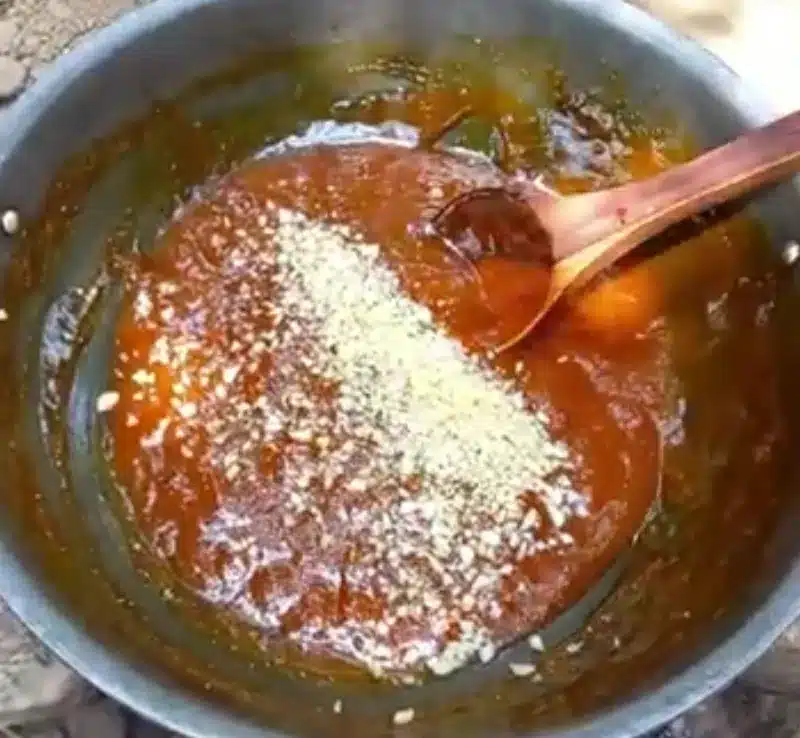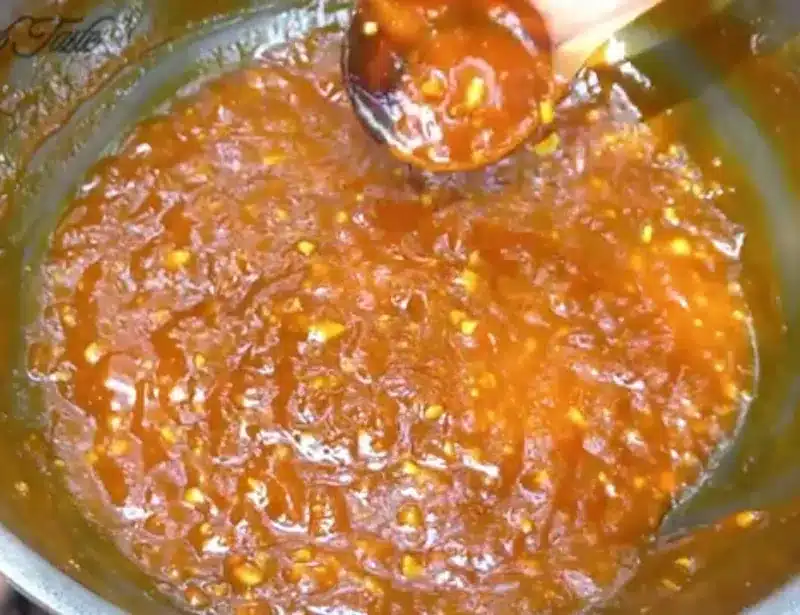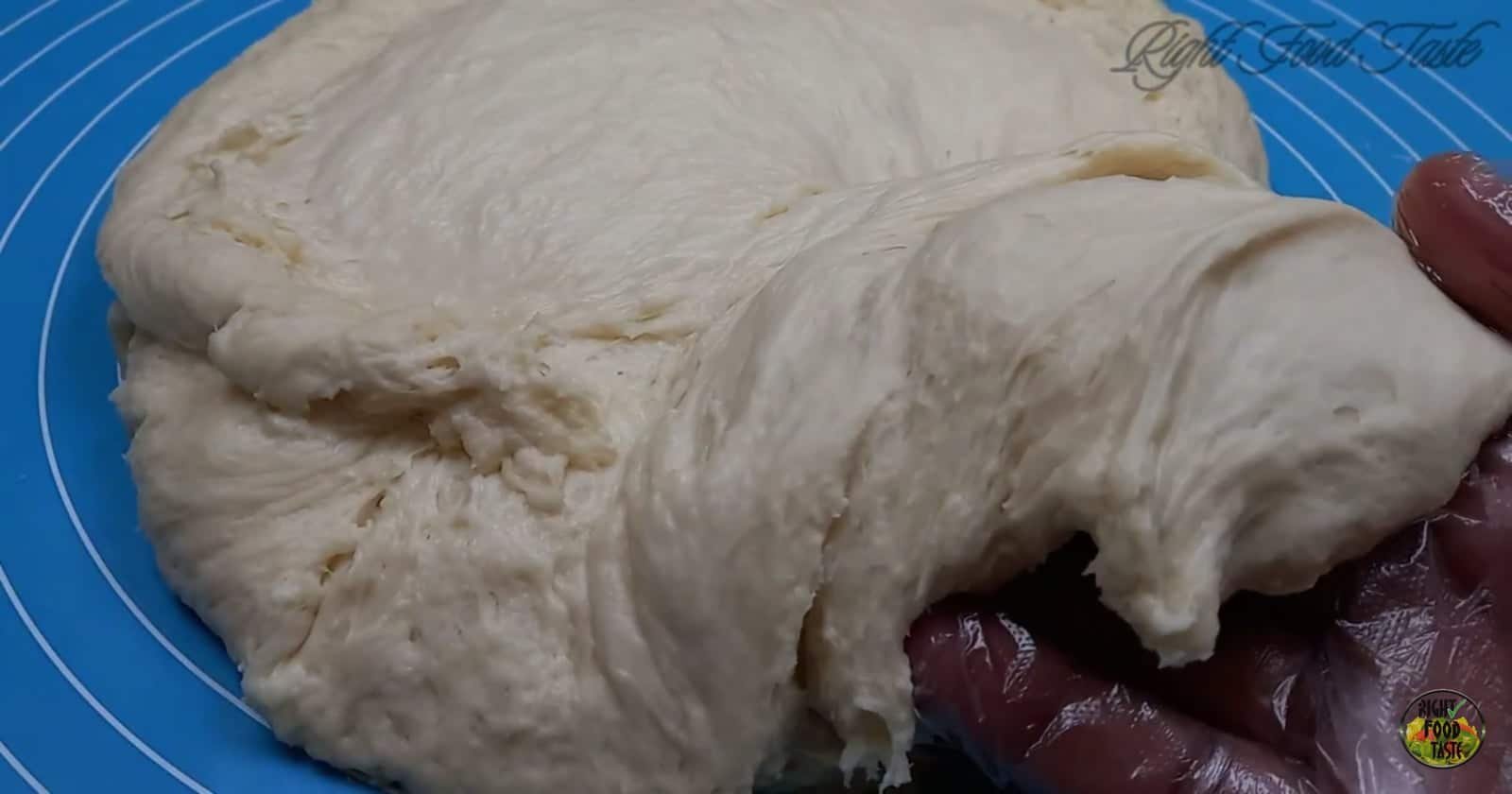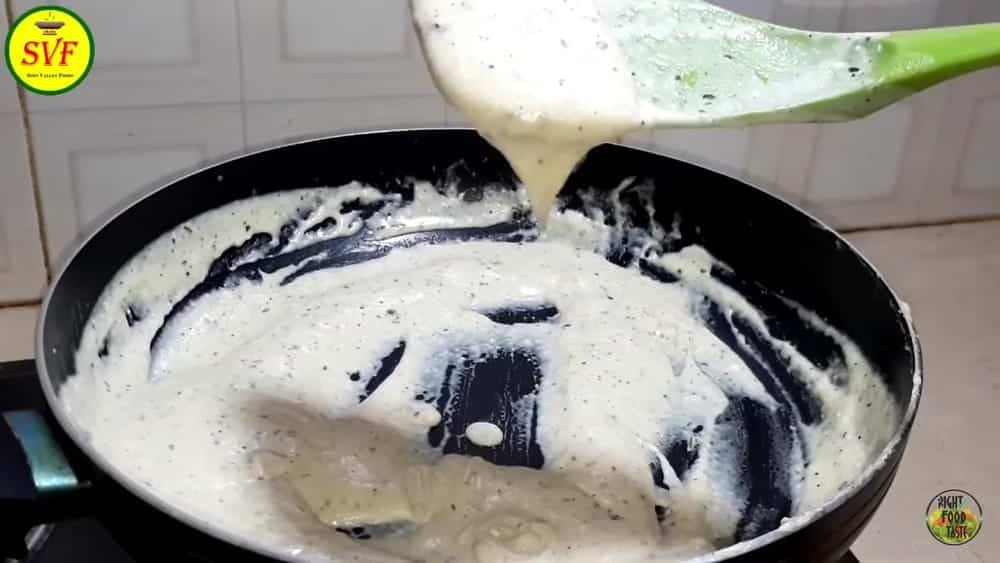Apricot jam is a classic and delicious spread that has been enjoyed worldwide for generations. With its vibrant orange color and fruity taste, it is a favorite among many jam lovers and a staple in many kitchens.
This is a sweet and fruity spread made from fresh apricots, sugar, and lemon juice – no pectin is required. The apricots are cooked down until they are soft and tender, and the mixture is then sweetened with sugar and brightened with the tangy flavor of lemon juice. The result is a smooth and velvety jam with vibrant orange color and a rich, fruity flavor.
Apricot jam is a versatile ingredient that can be used in various ways, such as a spreading on toast, biscuits, or scones, mixed into yogurt or oatmeal, or even used as a glaze for meat dishes or as a topping for desserts. Whether enjoyed as a simple spread or as a flavor-packed ingredient, it is a delicious addition to any kitchen pantry.
The great thing about making your own apricot jam is that it’s surprisingly easy and only requires a few simple ingredients. Here, we’ll go over a simple apricot jam recipe that you can try at home.
Reasons Why People Love Apricot Jam
There are many reasons why people enjoy apricot jam.
The sweet and slightly tangy flavor of the apricots combined with the richness of the sugar makes for a delicious and satisfying taste.
Apricot jam is a versatile ingredient that we use it in many different ways. It can be spread on toast or biscuits, used as a filling for cakes and pastries, or even used as a glaze for meat dishes.
It is also a good source of vitamins A and C, which are important for maintaining healthy skin and boosting the immune system.
For many people, the enjoyment of apricot jam comes from the nostalgia and memories associated with it. The taste and smell of homemade apricot jam can bring back fond memories of childhood, family gatherings, or special occasions, making it a cherished and beloved food for many people.
Best Apricot Jam Recipe
The best type of recipe for apricot jam really depends on personal taste preferences. Some people prefer a smooth and creamy jam, while others prefer a chunkier texture with pieces of fruit in the jam. Some recipes call for added ingredients such as spices or herbs to enhance the flavor of the jam.
However, in general, a good apricot jam recipe should use fresh and ripe apricots, a balanced amount of sugar and lemon juice to help preserve the jam and add flavor, and a cooking process that allows the apricots to break down and thicken into a jam-like consistency.
It’s always a good idea to try a few different recipes to find the one that best suits your taste and cooking style.
Variations of Apricot Jam Recipes
There are many different recipes to prepare apricot jam, each with its own unique twists and variations. When choosing a recipe, it is important to select one that suits your taste preferences and level of experience in making jams.
These are just a few examples of the many variations of apricot jam recipes that are available:
Classic Apricot Jam: This recipe involves cooking apricots, sugar, and lemon juice on the stovetop until they reach the desired consistency.
Honey Apricot Jam: This recipe uses honey instead of sugar as a sweetener, and includes a touch of cinnamon for added flavor.
Spiced Apricot Jam: This recipe includes warming spices such as ginger, cinnamon, and nutmeg for a cozy and flavorful jam.
Apricot Lavender Jam: This recipe includes dried lavender for a floral and fragrant twist on classic apricot jam.
Vanilla Bean Apricot Jam: This recipe uses fresh vanilla beans for a sweet and fragrant addition to the jam.
Apricot Amaretto Jam: This recipe includes amaretto liqueur for a delicious almond flavor that complements the apricots.
Apricot Ginger Jam: This recipe includes freshly grated ginger for a spicy and zesty kick to the apricot jam.
Major Ingredients of Homemade Apricot Jam
The main ingredients in the homemade apricot jam are fresh apricots, sugar, and lemon juice. Each ingredient plays a critical role in creating a delicious and well-preserved jam.
Fresh apricots: The star ingredient of the jam. Apricots contain natural pectin, which helps to thicken the jam when combined with sugar and heat. They also provide a sweet and slightly tangy flavor, which is the hallmark taste of apricot jam.
Apricots are a good source of vitamins and minerals, including vitamin C, potassium, and fiber. These nutrients in the jam, make it a nutritious and healthy spread.
Sugar: Sugar is an essential ingredient as it helps to preserve the jam, by binding with the pectin in the fruit to create a thick, sticky consistency. It also adds sweetness to the jam and balances out the tartness of the apricots.
While it’s possible to make jam with less sugar, it can affect the shelf life and texture of the final product. So, sugar is an essential ingredient in making apricot jam that helps to create its signature taste and texture.
Lemon juice: Adding lemon juice to jam increases the acidity level in the mixture, which helps to prevent the growth of harmful bacteria. It plays a critical role as it helps to balance the sweetness of the sugar and brings out the natural tartness of the apricots.
It also helps to activate the pectin in the fruit, which helps to thicken the jam and create a better texture. Lemon juice also adds a subtle citrus flavor to the jam.
Additional Flavors and Ingredients of Apricot Jam
There are many additional flavors and ingredients that we can add to apricot jam. Adding additional flavors and ingredients can help to elevate the flavor profile of the apricot jam and give it a unique twist that sets it apart from other jams.
Here are a few ideas:
Vanilla extract: Adding a small amount of vanilla extract can add a subtle sweetness and depth of flavor to the jam.
Cinnamon: A sprinkle of cinnamon can give it a warm and spicy flavor.
Almonds: Adding chopped almonds or almond extract can give the jam a nutty flavor and crunchy texture.
Ginger: Adding freshly grated ginger can give it a spicy and zesty kick.
Amaretto: A splash of amaretto liqueur can give the jam a delicious almond flavor.
Rosemary: Adding a sprig of fresh rosemary can give it a herbal, savory flavor.
Orange zest: Adding grated orange zest can add a bright citrus flavor to the jam.
How to Make Apricot Jam
If you’re interested in making your own apricot jam, it’s actually quite simple. To make homemade apricot jam, you will need fresh apricots, sugar, and lemon juice. Here is a simple recipe:
Preparation
- Here we have ½ kg fresh apricot. We will use apricots along with their skin.
- Start by washing the apricots thoroughly and cutting them in half and removing the pits.
Cooking the Jam
- Now put the apricots into the wok. Cook the apricots on medium-low flame. Stir for 2 to 3 minutes while pressing and chopping the apricots into small pieces with the spoon.
- Now add 1 cup of sugar or add sugar to taste. Stir well to combine. Simmer the mixture on medium-low flame for 12 to 13 minutes. Stirring occasionally until the sugar dissolves and the apricots have released their juices.
- Now add 1 tbsp freshly squeezed lemon juice. Stir it to combine and continue simmering for 8 to 10 minutes more, stirring occasionally. Be sure to keep an eye on the pot to prevent the mixture from burning.
- Add chopped almonds 2 minutes before achieving the desired consistency. Almonds give a nutty flavor and crunchy texture to the jam but if you don’t like you can skip it. Cook the jam for 2 minutes after adding the almonds.
- After about 25-30 minutes, the mixture should have thickened and reached the desired consistency, and it coats the back of a spoon.
- To test if it’s ready, you can use the “wrinkle test.” Place a small amount of the mixture onto a cold plate and wait a few seconds. If it wrinkles when you push it with your finger, it is ready.
Transferring the Jam to Sterilized Jars
- Turn off the flame and remove the pot from the heat and let it cool for a few minutes. Skim any foam off the top of the mixture, then transfer it to sterilized jars. Be sure to leave a little bit of space at the top of each jar.
- Seal the jars tightly and let them cool to room temperature. Once cooled, store the jars in the refrigerator for up to several months.
- The jar must be sterilized. You can use this jam for the whole season. Always use a dry spoon while taking the jam out of the jar. Using the wet spoon can reduce its shelf life and spoil the jam.
That’s it! With just a few simple ingredients and some patience, you can make your own delicious apricot jam at home. The beauty of this recipe is that you can adjust the sweetness and tanginess to your liking by adjusting the amount of sugar and lemon juice.
Enjoy your homemade jam on your favorite bread or as a topping for ice cream or yogurt. You can also enjoy your jam on toast, scones, or as a sweet glaze for meats. Give this recipe a try and let us know what you think!
Methods to Determine the Proper Consistency
Determining the proper consistency of homemade apricot jam is important to ensure that it spreads easily and has the right texture.
Here are some simple and effective ways to check if your jam has reached the proper consistency:
Spoon Test: Dip a clean spoon into the hot jam and lift it up. Hold the spoon sideways and watch how the jam falls off. If it falls off in large drops, the jam is still too runny. If it falls off in a sheet or flakes, it is ready.
Wrinkle Test or Plate Test: Take a small plate or saucer and place it in the freezer for a few minutes. Take a small spoonful of hot jam and place it on the chilled plate or saucer. Let it cool for a few seconds, then run your finger through the jam. If the surface wrinkles and holds its shape, the jam has reached the proper consistency.
If the jam does not wrinkle, return it to the heat and continue boiling for a few more minutes before testing again.
Temperature Test: Use a candy thermometer to check the temperature of the jam. When the temperature reaches 220°F (104°C), the jam has reached the proper consistency.
These methods are reliable ways to determine if your homemade jam has reached the right consistency. Remember, the jam will continue to thicken as it cools, so it’s better to err on the side of a slightly runny jam rather than overcooked jam that is too thick and hard to spread.
Shelf Life of Apricot Jam
The shelf life of homemade apricot jam depends on several factors, including the ingredients used, the storage conditions, and the level of acidity in the jam. In general, properly made and stored jam can last up to one year.
To ensure the longest shelf life for jam, it is important to follow proper canning procedures and store the jam in a cool, dry place away from direct sunlight. Always use clean, sterilized jars and lids to prevent contamination.
After opening, the shelf life of jam will be shorter, typically around one month if stored in the refrigerator. It is important to check for signs of spoilage, such as mold or off odors, before consuming jam.
Recipe Card

Apricot Jam Recipe
Ingredients
- ½ kg fresh apricots cut in half and pitted
- 1 cup sugar (or to taste)
- 1 tbsp lemon juice freshly squeezed
- 7-8 almonds chopped
Instructions
- Begin by washing the apricots thoroughly. We will use apricots with their skin.

- Cut them in half and remove the pits.

- Now put the apricots into a large pot or a wok. Cook the apricots on medium-low flame. Stir for 2 to 3 minutes while pressing and chopping the apricots into small pieces with the spoon.

- Next, add sugar. Stir well to combine. Simmer the mixture on medium-low flame for 12 to 13 minutes. Stirring occasionally until the sugar dissolves and the apricots have released their juices.

- Now add freshly squeezed lemon juice. Stir it to combine and continue simmering for 8 to 10 minutes more, stirring occasionally. Be sure to keep an eye on the pot to prevent the mixture from burning.

- Next, add chopped almonds. Almonds give a nutty flavor and crunchy texture to the jam but if you don’t like you can skip it.Add almonds two minutes before reaching the desired consistency. Cook the jam for 2 minutes after adding the almonds.

- After about 25-30 minutes, the mixture should have thickened and reached the desired consistency, and it coats the back of a spoon. To test if it's ready, you can use the "wrinkle test."

- Turn off the flame and remove the pot from the heat and let it cool for a few minutes. Skim any foam off the top of the mixture, then transfer it to sterilized jars.

- Be sure to leave a little bit of space at the top of each jar. Seal the jars tightly and let them cool to room temperature. Once cooled, store the jars in the refrigerator for up to several months.

- Enjoy your homemade jam on your favorite bread or as a topping for ice cream or yogurt. You can also enjoy your jam on toast, scones, or as a sweet glaze for meats. Give this recipe a try and let us know what you think!

Video
Apricot Jam Nutrition Facts
Here are the approximate nutrition facts for apricot jam per 1 tablespoon (20 grams) serving:
Calories: 44
Total Fat: 0 g
Saturated Fat: 0 g
Trans Fat: 0 g
Cholesterol: 0 mg
Sodium: 0 mg
Total Carbohydrate: 11 g
Dietary Fiber: 0.2 g
Total Sugars: 10 g
Protein: 0.1 g
Vitamin A: 55 IU
Vitamin C: 0.6 mg
Calcium: 1 mg
Iron: 0.1 mg
Please note that nutrition facts may vary slightly depending on the specific recipe and brand of jam used. It’s always a good practice to check the nutrition label on the specific product for accurate and up-to-date information. Additionally, portion sizes and consumption amounts may vary. So, it’s important to consider your overall diet and individual nutritional needs when consuming jam or any other food.
Tips for Preparing the Best Apricot Jam
Here are some important points to keep in mind when preparing homemade apricot jam. By following these points, you can ensure that your homemade jam turns out delicious and safe to consume.
Use fresh and ripe apricots: Choose apricots that are ripe but still firm to the touch. Overripe apricots may result in a jam that is too sweet and lacks flavor.
Use the right amount of sugar: The amount of sugar used in jam is important for both flavor and texture. Too much sugar can make the jam too sweet and too little sugar can result in a runny jam. Follow the recipe instructions carefully for the best results.
Add lemon juice: Adding lemon juice to jam can help balance the sweetness and add acidity. This can also help with preservation and prevent spoilage.
Cook the jam to the correct temperature: Cooking the jam to the correct temperature is important to achieve the desired texture and to kill any bacteria that may be present. Use a candy thermometer to ensure the jam reaches the correct temperature.
Sterilize jars and lids: Make sure to sterilize jars and lids before using them to prevent contamination and ensure the longest shelf life possible.
Use proper canning techniques: If canning the apricot jam, use proper canning techniques to create a vacuum seal and prevent contamination.
Store properly: Store the jam in a cool, dry place away from direct sunlight. Refrigerate after opening and use within one month.
A Versatile Ingredient in Cooking and Baking
Apricot Jam’s versatility and sweet flavor make it a popular ingredient in cooking and baking. It can also be a great homemade gift idea. Here are some common uses for apricot jam:
As a spread: Apricot jam is a delicious and sweet spread that can be enjoyed on toast, muffins, bagels, and other baked goods. It can also be used as a filling for cakes, pastries, and tarts.
Glazing and sauces: It can be used as a glaze for meats, such as lamb or chicken, giving them a sweet and tangy flavor. It can also be used as a base for sauces and dressings, adding a sweet and fruity flavor.
Marinades: Apricot jam can be used as a marinade for meats, adding flavor and helping to tenderize the meat.
Topping for ice cream or yogurt: It can be used as a topping for ice cream or yogurt, adding a sweet and fruity flavor.
Gift-giving: Homemade apricot jam can be a thoughtful and delicious gift for friends and family.
Advantages of Homemade Apricot Jam
Many people prefer to prepare apricot jam at home for a number of reasons.
First and foremost, homemade apricot jam can be customized to personal preferences, such as adjusting the sweetness or adding additional flavors like vanilla or cinnamon.
Secondly, homemade jam allows for the use of fresh, high-quality ingredients, which can result in a more flavorful and nutritious jam compared to store-bought options. Making jam at home also allows for greater control over the ingredients, such as reducing or eliminating preservatives or artificial colors and flavors.
Preparing apricot jam at home can also be a fun and rewarding experience, providing a sense of accomplishment and satisfaction from creating something delicious from scratch.
The Best Season to Prepare Apricot Jam
The best season to prepare apricot jam is during the summer months, typically from May to August, depending on the location. This is when apricots are in season and are at their freshest and most flavorful.
Using fresh, ripe apricots is important for making delicious jam, and the summer months provide the best opportunity to find high-quality apricots.
Additionally, preparing apricot jam during the summer allows us to enjoy the delicious flavor of apricots all year long, as we can store the jam for several months.
Selection of Best Apricots for Apricot Jam
The best apricots for apricot jam are ripe, locally grown, in season, free of blemishes, fragrant, and flavorful.
Choosing the best apricots for apricot jam is essential to ensure a delicious and high-quality product. Here are some tips on how to select the best apricots for making delicious homemade apricot jam:
Look for ripe apricots: The best apricots for jam making are ripe but still firm. They should have a bright orange-yellow color and a slight give when gently pressed.
Choose locally grown apricots: Locally grown apricots are usually fresher and have a better flavor than those that have been shipped long distances.
Pick apricots that are in season: Apricots are at their best during the summer months, typically from May to August. Choosing apricots in season will ensure that they are at their peak flavor and sweetness.
Check for blemishes: Avoid apricots that have blemishes or soft spots, as they may be overripe or begin to spoil.
Smell the apricots: Ripe apricots should have a sweet, fruity aroma. If they don’t have any scent, they may be underripe and lacking in flavor.
Taste the apricots: If possible, taste a small piece of the apricot before purchasing to ensure that it is sweet and flavorful.
Top Varieties of Apricots Used for Making Jam
The best apricots for making apricot jam are those that are ripe, flavorful, and have a good balance of sweetness and tartness.
The specific variety you choose will depend on personal preference and availability. Here are some of the top varieties of apricots that are commonly used for making jam:
Blenheim Apricots: Also known as the Royal Apricot, this variety is highly prized for its sweet and tangy flavor, making it a popular choice for jam making.
Moorpark Apricots: This variety of apricot has a vibrant orange color and sweet, juicy flesh, making it an excellent choice for making jam.
Goldrich Apricots: Goldrich apricots are a popular choice for jam making because they are highly flavorful, juicy, and have a good balance of sweetness and acidity.
Perfection Apricots: This variety is prized for its large size and excellent flavor, making it a great choice for making large batches of apricot jam.
Tilton Apricots: This variety has a firm texture and a sweet, tangy flavor, making it an excellent choice for making apricot jam.
Methods to Preserve the Apricot Jam
We can preserve homemade apricot jam using a variety of methods, including canning, freezing, and refrigeration. The method you choose will depend on your personal preference and the equipment you have.
Properly preserved homemade jam can last for several months to a year, depending on the method used.
Canning: Canning is a popular method for preserving homemade jam. To can apricot jam, the jam is first cooked and then poured into sterilized jars. The jars are then processed in a boiling water bath to create a vacuum seal. Canned jam can last for up to one year when stored in a cool, dry place.
Freezing: Freezing is another option for preserving jam. To freeze it, allow the jam to cool completely, then transfer it to a freezer-safe container or freezer bag. Frozen jam can last for up to six months in the freezer.
Refrigeration: Refrigeration is the easiest method for preserving homemade jam. After cooking, allow the jam to cool, then transfer it to clean, sterilized jars and store them in the refrigerator.
FAQs
How can we avoid homemade apricot jam from contamination?
Contamination can lead to spoilage and foodborne illness in homemade apricot jam, so it is important to take steps to prevent contamination when making and storing the jam:
Here are some ways to avoid contamination and ensure that your homemade jam is safe to consume.
Use clean and sterilized equipment: Make sure all equipment used in making jam, including utensils, jars, and lids, are clean and sterilized before use. You can sterilize equipment by boiling them for 10 minutes or running them through a dishwasher cycle.
Use fresh ingredients: Choose fresh and ripe apricots and other ingredients for making apricot jam. Avoid using ingredients that are past their prime or have signs of mold or spoilage.
Cook thoroughly: Proper cooking is important to kill any bacteria that may be present in the jam. Follow the recipe instructions carefully and make sure to cook the jam for the recommended time and temperature.
Seal jars properly: Properly sealing the jars is important to prevent contamination. Make sure the lids are properly secured and that the jars are processed according to the canning method used.
Store properly: Store the jam in a cool, dry place away from direct sunlight. Avoid storing jars in areas where there may be temperature fluctuations, such as near a stove or refrigerator.
Is apricot jam vegan?
In general, apricot jam can be considered vegan, as it is typically made from apricots, sugar, and acid (such as lemon juice) without the use of animal-derived ingredients.
It’s important to always check the specific brand or recipe of jam, as some variations or commercial brands may use animal-derived ingredients or processing methods that may not align with a vegan diet.
For example, some apricot jam recipes or commercial brands may use gelatin as a thickening agent, which is derived from animal bones or connective tissue and would not be considered vegan.
Additionally, some apricot jams may be processed using filtering methods that involve animal-derived substances, such as bone char, which is used in sugar refining.
It’s always recommended to carefully read ingredient labels and verify with the manufacturer or recipe source to ensure that the apricot jam is suitable for a vegan diet.

